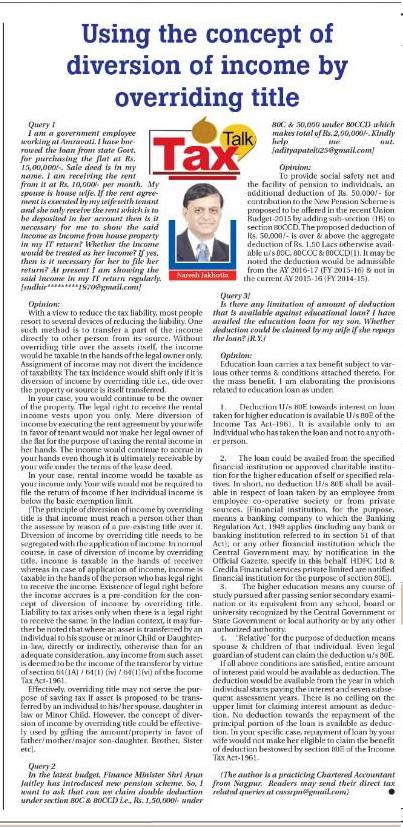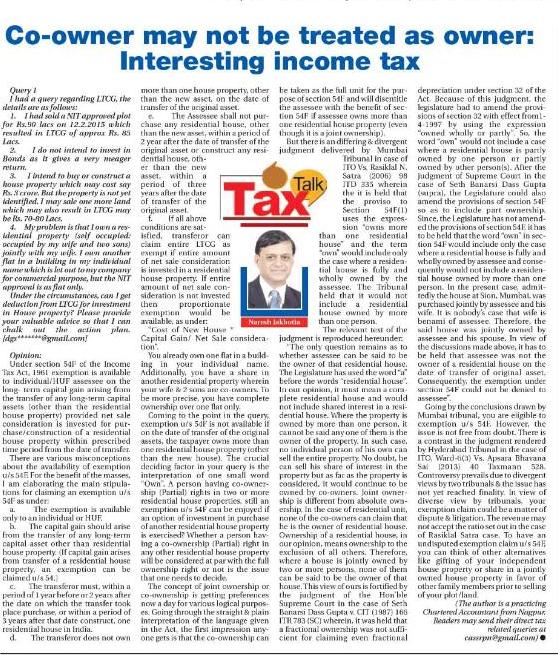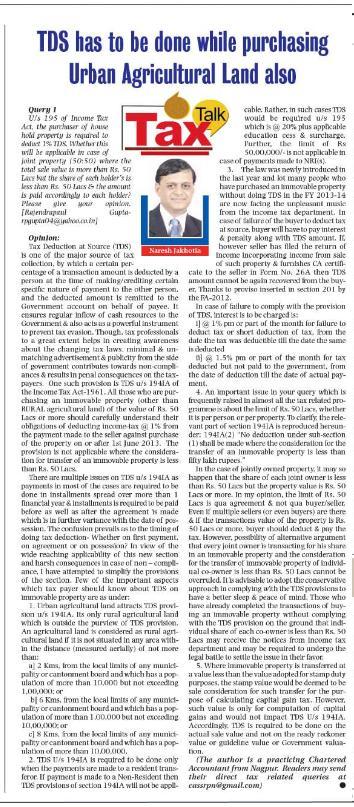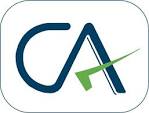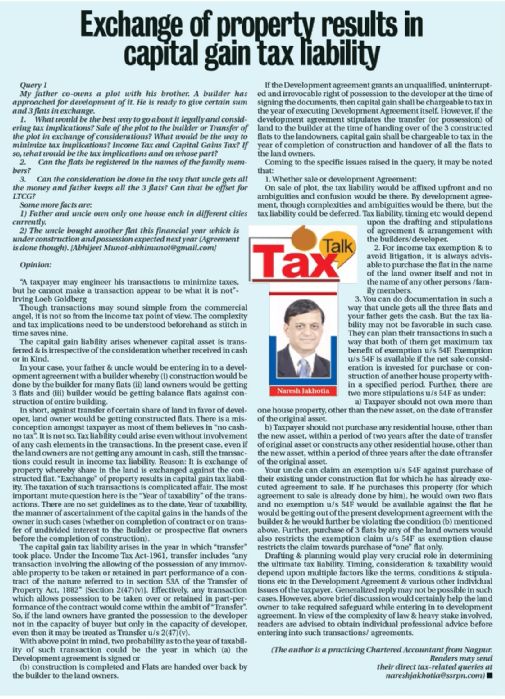Article Details
| Deductor liable for penalty @ Rs. 100/- per day if TDS certificates are not downloaded | |
|
TAX TALK-27.07.2015-THE HITAVADA TAX TALK CA. NARESH JAKHOTIA Chartered AccountantDeductor liable for penalty @ Rs. 100/- per day if TDS certificates are not downloaded Query 1] My query is to whom the downloading of quarterly form No 16 is mandatory? Whether it is mandatory for the salaried class people who are working under the Government, or working under the private establishment? Kindly explain. [Renuka Aparajit- dkale7710@gmail.com] Opinion: Section 203 of the Income-tax Act 1961 (read with the Rule 31 of the Income-tax Rules 1962) stipulates furnishing of certificate of tax deduction at source (TDS) by the deductor to the deductee in the prescribed form. The relevant form for such TDS certificate is Form No. 16 in case of deduction under section 192 (i.e., Salary TDS) and Form No. 16A for non salary TDS. TDS certificate in Form No. 16 is to be issued annually whereas TDS certificate in Form No. 16A is to be issued quarterly. With a view to streamline the TDS procedures & for proper administration, CBDT had issued Circular No. 03/2011 dated 13.05.2011 and Circular No. 01/2012 dated 09.04.2012 making it mandatory for all deductor to issue TDS certificate in Form No. 16A after generating and downloading the same from TDS Reconciliation Analysis and Correction Enabling System (TRACES) accessible at https://www.tdscpc.gov.in. There is no obligation on the deductee to download the TDS certificate. The obligation to download & issue the TDS certificate is on the deductor alone. It may further be noted that if deductor fail to download & issue the TDS certificate within prescribed time, penalty @ Rs. 100/- per day is leviable u/s 272A of the Income Tax Act-1961. Query 2] I have received two properties as per the will of my father. First plot is of 1695 sq.ft. with old structure which is in dismantling position. Second plot is of 1830 sq.ft. with two storied RCC building measuring 1400 sq.ft. (Father will Dated: 25/11/2002). On 18/6/2015 I have sold first plot of 1695 sq.ft. The amount received by me is Rs 70 Lacs. The amount is invested in my sons business. (Father had received his share in ancestral properties in 1975 by family partition & secondly as per will of my grandfather in 1994). Please let me know amount of tax to be paid and its last date of payment? I had already paid TDS of Rs. 70,000/- on 18/06/2015. Second part From my second property which has 4 shops on ground floor and one Residential flat on first floor, I have sold one shop measuring 150 sq.ft. (10 ft x 15 ft) for Rs. 12 Lacs on 26/08/2014. Total amount has been invested in business. I have paid Rs. 85,000/- as advance tax on 04/03/2015. I do not have any other income except agriculture. Please let me know tax position of the said transaction with its payment date.[R.K.Jain-kreftfurniture@gmail.com] Opinion 1. Both the properties which you have sold were an ancestral property acquired by the original owner (i.e., grandfather) before 1981. You have inherited the property from your father who in turn has inherited the same from his father. 2. Mode of computing Taxable income in such transactions: a] Any income from transfer of property is taxable as “Capital Gain” income. If the property is sold after a holding period of more than 36 months, it is taxable as Long Term Capital Gain (LTCG). b] LTCG could be computed by reducing the expenses in connection with the transfer & indexed cost of acquisition/improvement from the amount of full value consideration. c] Full value consideration is nothing but higher of (i) actual sale price or (ii) stamp duty valuation adopted by the registrar for levy of stamp duty. c] Since the property sold by you is an ancestral property acquired originally prior to 1981, you have to ascertain the Fair market value (FMV) of the property as on 01.04.1981. FMV as on 01.04.1981 could be taken as “Cost of Acquisition”. d] On the FMV as on 01.04.1981, you would be eligible for Indexation benefit to compensate the inflationary effect of money. 1981-82 would be the base year with Cost Inflation Index (CII) at “100”, whereas CII for the relevant FY 2015-16 & FY 2014-15 are “1081” & “1024” respectively. e] Expenses like renovation, repairs, additions etc incurred after 01.04.1981 could be considered as “Cost of Improvement” which could also be reduced from the amount of full value consideration while computing LTCG. Indexation benefit would also be available on the cost of improvement also. f] You can further claim deduction towards expenses like brokerage, legal fees etc paid for while completing your sale transactions as the same could be considered as “Expenses in connection with transfer”. 3. You have sold the shop in the FY 2014-15 whereas property of 1695 sq.ft is sold by you in the FY 2015-16. Capital gain from both the property will be taxable in different financial year. 4. LTCG computed above would be taxable @ 20%. Since you don’t have any other taxable income, you can reduce the amount of basic exemption limit from your LTCG and the balance amount would be subject to special rate of income-tax @ 20%. You have to pay the tax, after reducing prepaid taxes (like TDS & Advance tax) before filing your income tax return. 5. You have not mentioned the nature of business of your son. There is no blanket tax benefit available to you for direct investment in the existing business of your son. There is one provision that offers offer tax benefit against LTCG arising from transfer of residential property (a house or a plot of land) by an individual & HUF for investment in manufacturing business. The same is incorporated in section 54GB of the income tax Act-1961 & is available only against the transfer that took place in between 01.04.2012 to 31.03.2017. Other stipulations of section 54GB are as under: a] For exemption, taxpayer have to utilize the net sale considerations for subscription in the equity shares of a newly incorporated company on or after April 1st of the financial year in which residential property is transferred but on or before the due date of submission of return of income. [Investment in the already running business of the taxpayer would not be eligible for exemption. The new company incorporated during the relevant period only is eligible for exemption]. b] The company should be engaged in the business of manufacture of any articles or thing & should qualify as SME (i.e., investment in plant and machinery is more than Rs. 25 Lacs but not more than Rs. 10 Crore). c] The taxpayer (i.e., transferor of residential property) should have more than 50% share capital (or voting right) after subscription in the shares of the company. d] The company should utilize the proceeds for purchase of new plant & machinery within a prescribed time. [Office appliances, vehicles etc are not considered as plant & machinery for the purpose of exemption]. e] There is a restriction of 5 years against transfer of shares as well new assets.
[The author is a practicing Chartered Accountant from Nagpur. Readers may send their direct tax related queries at SSRPN & Co, 10, Laxmi Vyankatesh Apartment, C.A. Road, Telephone Exch. Square, Nagpur-440008 or email it at nareshjakhotia@ssrpn.com] |
|
 |




.png)
